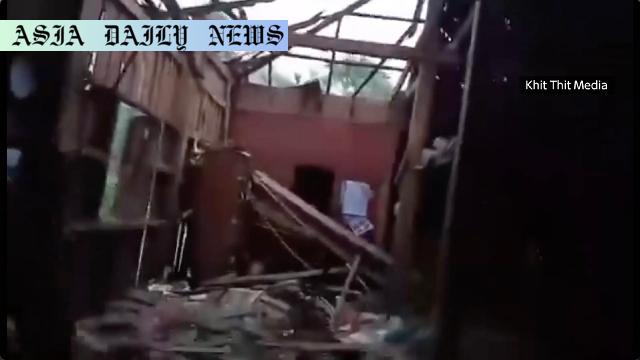Ceasefire: Myanmar’s military extends its ceasefire until June 30, citing reconstruction efforts after March’s devastating earthquake.

Ceasefire Extension Amidst Humanitarian Crisis
The Myanmar military junta has announced the extension of a previously declared ceasefire with pro-democracy factions until June 30. This step comes in the aftermath of a devastating earthquake in March that claimed over 3,700 lives and left over 5,000 injured. Officials claim that the ceasefire is a necessary move to focus on reconstruction and rehabilitation, particularly in regions hardest hit by the natural disaster. However, ongoing conflicts and skepticism from pro-democracy groups suggest that the humanitarian intentions of the junta bear a heavy undercurrent of political turbulence.
The initial ceasefire was introduced as a temporary effort to unify resources for relief endeavors following the earthquake. It marked a rare moment of accord, albeit shadowed by the military’s controversial governance after their seizure of power in 2021. The junta’s public statement clarifies their commitment to accelerating rehabilitation efforts post-earthquake. Yet, trust issues between opposing parties have derailed the potential for even a fleeting sense of unity. Accusations of treachery, substantiated by reports of targeted attacks on civilian zones such as schools and hospitals, have further eroded any semblance of good faith among belligerent actors.
Pro-Democracy Factions Skeptical of Military’s Intentions
Pro-democracy groups and activists have dismissed the ceasefire announcement, decrying it as fraudulent. Their allegations, amplified through local and international media platforms, accuse the military of executing airstrikes and attacks, even during the declared cessation period. Regional sources confirm reports of continuous violence, including a harrowing incident last month in Sagaing where over 20 school children perished during a military airstrike. This tragedy underscores persistent concerns that the ceasefire is more a façade than a genuine peace-building effort meant to cater to Myanmar’s war-weary population.
The Association of Southeast Asian Nations (ASEAN) has also expressed concern, urging all parties towards building trust and expanding the scope of a ceasefire. Although supportive of dialogue and negotiation, ASEAN’s repeated calls for peace have yielded little to no visible de-escalation, as both the military and resistance forces prioritize their interests on the battlefield over broader humanitarian needs.
Reconstruction or More Political Maneuvering?
The junta’s intent to focus on reconstruction aligns with their narrative of post-disaster relief leadership. However, tangible efforts on the ground remain minimal and shrouded by an overarching political agenda. The Myanmar populace, already struggling under the weight of political unrest and its humanitarian crisis, is caught in the crossfire of conflicting ideologies and power structures. Beyond reconstruction, a larger question looms: Can Myanmar forge a path to peace while addressing the grievances and needs of its diverse population?
Transitioning from crisis management to structural repair requires unwavering cooperation on all fronts, but Myanmar’s history of internal strife poses significant barriers. What becomes evident is a critical need for sustained international attention and mediation. If these immediate concerns are left unaddressed, Myanmar faces a prolonged period of political upheaval, compounded by an escalating humanitarian crisis.
Commentary
The Fragility of Myanmar’s Ceasefire
The recent ceasefire extension by Myanmar’s junta, ostensibly focusing on reconstruction efforts, sparks a mix of hope and pessimism. While the declared aim of prioritizing recovery in earthquake-affected regions seems commendable on the surface, the reality of sustained violence betrays the complexity of the situation. This raises the pressing question of whether such ceasefires are genuine efforts toward de-escalation or merely political tools to consolidate control amidst external and internal pressure.
Pro-Democracy Concerns and Ongoing Violence
The concerns of pro-democracy factions cannot be dismissed lightly. Allegations of continuing attacks, particularly on civilian institutions like schools and hospitals, highlight the precariousness of the ceasefire’s credibility. The tragic airstrike in Sagaing, which claimed the lives of over 20 children, stands as a grave reminder of the ongoing price of discord in Myanmar. For the military, these continued operations can be perceived as a dual-purpose strategy: suppress the resistance while maintaining a perception of humanitarian awareness. For opponents, it signals betrayal and poses an existential threat to pro-democracy movements.
A Need for International Intervention
In such a fractured landscape, international organizations like ASEAN face a mammoth challenge in bridging the gap between hostility and dialogue. While pushing for an expanded ceasefire may seem like a feasible solution, implementation remains a significant hurdle without mechanisms to enforce compliance. Ground realities demand not just declarations but measurable actions that prioritize the safety, well-being, and voices of Myanmar’s citizens.
As global observers, we must hold all actors accountable, ensuring that the unresolved grief and untold suffering of civilians are not overshadowed by the broader political chess game. For Myanmar, genuine peace remains an elusive prospect, but every small step toward resolution could serve as a foundation for a brighter and more inclusive future.


